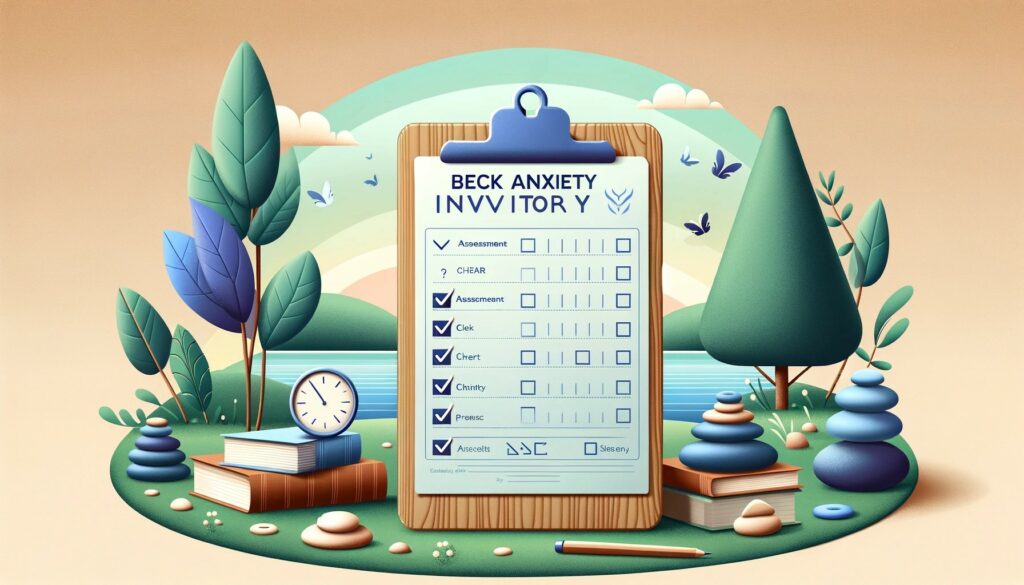The Beck Anxiety Inventory, commonly referred to as BAI, is a widely used questionnaire designed to measure the severity of anxiety symptoms in individuals. Developed by Dr. Aaron T. Beck and his colleagues, this inventory has become an essential tool in both clinical and research settings for assessing anxiety levels.
With its 21-item scale, the BAI covers various symptoms related to anxiety such as nervousness, fearfulness, and restlessness. Each item is rated on a scale from 0 (not at all) to 3 (severely), allowing individuals to express the intensity of their anxiety experiences. By summing up the scores of all items, clinicians can obtain a total score that reflects the overall level of anxiety present.
One notable feature of the BAI is its ability to differentiate between symptoms of anxiety and depression, providing a clearer understanding of an individual’s mental health status. The inventory also helps track changes in anxiety levels over time, making it valuable for treatment planning and evaluating therapeutic interventions.
In conclusion, the Beck Anxiety Inventory offers a comprehensive assessment of anxiety symptoms and plays a crucial role in diagnosing and monitoring anxiety disorders. Its standardized format provides clinicians with valuable insights into an individual’s emotional well-being and guides them towards appropriate treatment strategies tailored to each patient’s needs.
Understanding the Beck Anxiety Inventory
Let’s dive into the topic of the Beck Anxiety Inventory and gain a better understanding of what it entails. The Beck Anxiety Inventory (BAI) is a widely used self-report questionnaire designed to measure the severity of anxiety symptoms in individuals. Developed by Aaron T. Beck and his colleagues, this inventory consists of 21 items that assess various physiological and cognitive symptoms associated with anxiety.
The BAI aims to provide clinicians and researchers with valuable insights into an individual’s level of anxiety. By asking respondents to rate each item on a scale from 0 to 3 based on how much they have been bothered by each symptom over the past week, the inventory helps quantify anxiety levels. The total score obtained from summing up these ratings can then be interpreted as an indication of anxiety severity.
One key advantage of the BAI is its ability to differentiate between general anxiety disorder (GAD) and other psychiatric conditions such as depression or panic disorder. While there may be overlapping symptoms among these disorders, the specific items included in the BAI allow for a more accurate assessment of anxiety-related symptoms specifically.
It’s important to note that while the BAI provides valuable information about an individual’s anxiety levels, it should not be used as a standalone diagnostic tool. Instead, it serves as a complementary assessment alongside clinical interviews and other measures. Additionally, interpretation of scores should always take into account cultural factors, personal circumstances, and any relevant clinical context.
In conclusion, gaining an understanding of the Beck Anxiety Inventory helps us appreciate its role in assessing anxiety severity. By utilizing this self-report questionnaire alongside other diagnostic tools, clinicians can gather comprehensive information about their patients’ experiences with anxiety.
The Importance of Assessing Anxiety Levels
Understanding and assessing anxiety levels is crucial for individuals, healthcare professionals, and researchers alike. It provides valuable insight into the impact of anxiety on a person’s well-being and allows for targeted interventions to be implemented. Let’s delve into why assessing anxiety levels is so important.
- Personalized Treatment: Assessing anxiety levels helps in tailoring treatment plans according to individual needs. By understanding the severity of anxiety symptoms, healthcare professionals can determine whether therapy, medication, or a combination of both would be most effective. This personalized approach increases the chances of successful intervention and improves overall patient outcomes.
- Early Detection: Identifying anxiety early on can prevent it from escalating into more severe mental health issues such as panic disorders or depression. Regular assessment allows people to recognize their symptoms and seek appropriate help promptly. It also enables healthcare providers to intervene at an early stage, reducing the potential long-term negative effects of untreated anxiety.
- Monitoring Progress: By consistently assessing anxiety levels over time, individuals and therapists can track progress during treatment or therapy sessions. This monitoring process helps gauge the effectiveness of interventions, make necessary adjustments if needed, and celebrate milestones achieved along the way. It provides individuals with a sense of control over their mental health journey.
- Research Insights: Assessing anxiety levels across different populations contributes to valuable research data that expands our understanding of this complex condition. Such studies provide insights into prevalence rates, risk factors, treatment efficacy, and inform public health policies aimed at improving mental well-being globally.
- Informing Public Health Initiatives: Accurate assessment data plays a vital role in developing evidence-based public health initiatives targeting anxiety disorders within communities or specific demographics. These initiatives may include awareness campaigns, educational programs in schools and workplaces, or improved access to mental health services in underserved areas.
In conclusion (without starting with “In conclusion”), assessing anxiety levels is essential for tailoring treatment plans, detecting anxiety early on, monitoring progress, contributing to research, and informing public health initiatives. By understanding anxiety levels, we can better support individuals experiencing anxiety and work towards improving mental well-being on a larger scale.
Administering and Scoring the Beck Anxiety Inventory
Let’s dive into the process of administering and scoring the Beck Anxiety Inventory (BAI). This widely used self-report questionnaire is designed to assess the severity of anxiety symptoms in individuals. The BAI consists of 21 items, each describing a common symptom of anxiety, such as “feeling nervous” or “experiencing heart palpitations.”
To administer the BAI, it is essential to provide clear instructions to participants. You can explain that they should read each statement carefully and rate how much they have been bothered by that particular symptom over the past week. The rating scale ranges from 0 (not at all) to 3 (severely), allowing individuals to indicate the intensity of their experience.
Once participants have completed the inventory, it’s time for scoring. Each item on the BAI is assigned a score according to its rating: 0, 1, 2, or 3. By summing up these scores across all items, you obtain a total score that reflects an individual’s level of anxiety. Higher scores indicate more severe symptoms.
Interpreting the results requires comparing an individual’s total score with established cutoff points. These cutoffs help determine if someone falls within normal range or if they may be experiencing mild, moderate, or severe levels of anxiety. It is important to note that while the BAI provides valuable insights into one’s anxiety symptoms, it does not diagnose any specific disorder but rather serves as a screening tool.
In research and clinical settings alike, understanding how to properly administer and score the Beck Anxiety Inventory is crucial for accurate assessments. By following standardized procedures and taking into account established cutoffs for interpretation, professionals can gain valuable information about an individual’s anxiety levels and tailor appropriate interventions accordingly.
In summary, administering and scoring the Beck Anxiety Inventory involves providing clear instructions for respondents to rate their experience of various anxiety symptoms over a specific timeframe. Scoring is done by assigning values to each response and summing them up to obtain a total score. Interpreting the results involves comparing the total score with established cutoff points to gauge the severity of anxiety symptoms.
Interpreting the Results of the Beck Anxiety Inventory
When it comes to interpreting the results of the Beck Anxiety Inventory (BAI), there are a few key factors to consider. The BAI is a widely used self-report questionnaire designed to measure the severity of anxiety symptoms in individuals. By understanding how to interpret these results, you can gain valuable insights into an individual’s level of anxiety and guide appropriate interventions or treatments.
-
Understanding BAI Scores:
The first step in interpreting BAI results is understanding the scoring system. The questionnaire consists of 21 items that assess various symptoms related to anxiety, such as nervousness, fear, and restlessness. Each item is rated on a scale from 0 (not at all) to 3 (severely). The total score ranges from 0 to 63, with higher scores indicating greater levels of anxiety.
-
Interpreting Score Ranges:
To make sense of the scores obtained from the BAI, it’s helpful to refer to established ranges for interpretation. Generally, score ranges are divided into four categories: minimal (0-7), mild (8-15), moderate (16-25), and severe (26 and above) anxiety levels. These ranges provide a framework for understanding where an individual falls on the spectrum of anxiety severity.
-
Seeking Professional Guidance:
While understanding score ranges can offer insight into an individual’s level of anxiety, it’s important not to rely solely on self-diagnosis or self-assessment based on these scores. Consulting with a mental health professional who specializes in anxiety disorders can help provide a more comprehensive evaluation and guide appropriate treatment options tailored specifically to an individual’s needs.
-
Considering Contextual Factors:
It’s crucial to consider contextual factors when interpreting BAI results. Anxiety symptoms can vary greatly among individuals due to personal circumstances, cultural differences, or co-existing conditions like depression or substance abuse disorders. Therefore, it is important to take into account the individual’s unique background and any other relevant factors that may influence their anxiety levels.
By understanding how to interpret the results of the Beck Anxiety Inventory, you can gain valuable insights into an individual’s level of anxiety. However, it is essential to remember that this inventory should not be used as a standalone diagnostic tool. Consulting with a mental health professional is always recommended for a comprehensive assessment and appropriate treatment planning.
Limitations and Considerations for Using the Beck Anxiety Inventory
When utilizing the Beck Anxiety Inventory (BAI) as a tool for assessing anxiety levels, it is important to be aware of certain limitations and considerations. While the BAI is widely used and has proven to be a valuable resource in many clinical settings, it’s essential to understand its potential shortcomings. Here are some factors to keep in mind when using the BAI:
- Subjective Nature: The BAI relies on self-reporting, meaning that individuals assess their own anxiety symptoms based on their perception. This subjective nature can introduce a degree of variability and potential bias into the results. It’s important to consider that different individuals may interpret and respond to the inventory items differently.
- Limited Scope: The BAI primarily focuses on measuring symptoms specifically related to anxiety disorders, rather than capturing broader aspects of mental health or emotional well-being. Therefore, it may not provide a comprehensive picture of an individual’s overall psychological state or identify other co-occurring conditions.
- Cultural Sensitivity: The BAI was originally developed in Western cultural contexts, which may influence its applicability and validity across diverse populations. It’s crucial to consider cultural variations in expressions of anxiety and adapt assessment methods accordingly for accurate interpretation.
- Time Sensitivity: The BAI assesses anxiety symptoms experienced within the past week only, which means it may not capture fluctuations or long-term patterns of anxiety over time accurately. For a more comprehensive understanding, additional assessments or repeated measurements might be necessary.
- Limitations in Clinical Decision Making: Although useful as an initial screening tool, the BAI alone should not solely determine diagnostic decisions or treatment plans without considering other relevant clinical information and professional judgment.
By being mindful of these limitations when using the Beck Anxiety Inventory, healthcare professionals can better interpret results and make informed decisions regarding diagnosis and treatment options for patients experiencing symptoms of anxiety disorders.
Alternative Assessment Tools for Measuring Anxiety
When it comes to measuring anxiety, the Beck Anxiety Inventory (BAI) is a widely used and well-established tool. However, there are also alternative assessment tools that can provide valuable insights into an individual’s level of anxiety. These tools complement the BAI and offer different perspectives on anxiety measurement. Let’s explore a few examples:
- State-Trait Anxiety Inventory (STAI): This tool assesses both state anxiety (temporary feelings of apprehension or tension) and trait anxiety (generalized tendency to perceive situations as threatening). The STAI consists of separate questionnaires for each type of anxiety, making it useful for distinguishing between short-term and long-term anxiety patterns.
- Hospital Anxiety and Depression Scale (HADS): Although primarily designed to measure depression, HADS also includes a subscale specifically focused on assessing anxiety symptoms. It evaluates the severity of emotional distress experienced by individuals in medical settings, providing valuable information about their overall psychological well-being.
- Generalized Anxiety Disorder 7-Item Scale (GAD-7): GAD-7 is a brief self-report questionnaire that screens for generalized anxiety disorder based on seven core symptoms associated with this condition. It measures the frequency and severity of these symptoms over the past two weeks, offering a quick snapshot of an individual’s level of anxiety.
- Penn State Worry Questionnaire (PSWQ): This tool is designed specifically to measure excessive worry, which is a hallmark feature of generalized anxiety disorder. The PSWQ consists of 16 items that assess the frequency and intensity of worrisome thoughts across various life domains.
- Hamilton Anxiety Rating Scale (HAM-A): Widely used in clinical settings, HAM-A provides a comprehensive evaluation of anxiety symptoms through observations made by healthcare professionals or trained interviewers. It covers physical as well as psychological manifestations of anxiety.
These alternative assessment tools expand our understanding of anxiety by focusing on specific aspects such as state vs. trait anxiety, worry levels, and clinical observations. While the BAI remains a valuable tool, incorporating these alternatives can offer a more comprehensive assessment of an individual’s anxiety profile.
Remember, it’s important to consult with mental health professionals who are experienced in administering and interpreting these assessment tools to ensure accurate results and appropriate interventions.
Applying the Findings from the Beck Anxiety Inventory in Clinical Practice
When it comes to utilizing the findings from the Beck Anxiety Inventory (BAI) in clinical practice, there are several ways that this assessment tool can provide valuable insights and guide treatment.
Here are a few examples:
- Identifying anxiety levels: The BAI is designed to measure the severity of anxiety symptoms experienced by individuals. By administering this inventory, clinicians can gain a better understanding of their patients’ anxiety levels and how it may be impacting their daily lives. This information becomes crucial in tailoring appropriate interventions and treatment plans.
- Monitoring treatment progress: As therapy progresses, it’s important to assess whether interventions are effectively reducing anxiety symptoms. The BAI can be used at regular intervals to track changes in symptom severity over time. By comparing scores from different assessments, clinicians can objectively evaluate the effectiveness of therapeutic approaches and make necessary adjustments.
- Informing treatment decisions: The BAI provides valuable information about specific symptom clusters related to anxiety disorders, such as cognitive, physiological, and emotional manifestations. By analyzing these results alongside other clinical observations, clinicians can gain insights into which areas require focused intervention or targeted therapies.
- Enhancing client-clinician communication: The BAI can serve as a helpful tool for facilitating discussions between clients and clinicians about their anxiety experiences. It provides a common language for describing symptoms and allows both parties to have a shared understanding of the individual’s struggles. This enhanced communication fosters collaboration and empowers clients to actively participate in their own treatment process.
- Research purposes: Beyond its application in clinical practice, data collected through the BAI can contribute to research studies aimed at further understanding anxiety disorders and developing evidence-based treatments. Aggregated results from multiple assessments using this inventory help researchers identify trends, patterns, and potential new avenues for intervention.
Incorporating the findings from the Beck Anxiety Inventory into clinical practice offers numerous benefits, ranging from individualized treatment planning to advancing our collective knowledge about anxiety disorders. By leveraging the insights provided by this assessment tool, clinicians can make informed decisions and guide their clients towards improved mental well-being.
In summary, the Beck Anxiety Inventory (BAI) is a valuable tool for assessing and measuring anxiety levels in individuals. Through its various scales and questions, it provides clinicians and researchers with valuable insights into the severity of anxiety symptoms and their impact on daily functioning.
- Assessment Accuracy: The BAI has been widely studied and validated, demonstrating strong psychometric properties. Its reliability and validity make it an effective instrument for accurately assessing anxiety levels across diverse populations.
- Clinical Utility: The BAI offers several advantages in clinical practice. It helps professionals identify individuals who may require intervention or treatment for anxiety disorders. Moreover, it can track changes in symptom severity over time, enabling clinicians to monitor treatment progress effectively.
- Research Applications: Researchers also benefit from the BAI’s comprehensive assessment of anxiety symptoms. By using this inventory, they can investigate the efficacy of different therapeutic approaches or study the impact of anxiety on specific populations or conditions.
- Self-Report Tool: One notable advantage of the BAI is that it relies on self-reporting rather than clinician interpretation alone. This allows for greater transparency as individuals directly report their own experiences and perceptions regarding anxiety symptoms.
- Limitations: Although highly useful, the BAI does have some limitations that should be considered when interpreting results. For example, it solely focuses on assessing symptoms related to generalized anxiety disorder (GAD) and may not capture other specific anxiety disorders adequately.
- Further Research Opportunities: Continued research is necessary to explore potential modifications or adaptations of the inventory to address these limitations further. Additionally, investigating its applicability across different cultural contexts could contribute to enhancing its accuracy and effectiveness.
Overall, the Beck Anxiety Inventory serves as a valuable tool in both clinical practice and research settings by providing reliable assessments of anxiety levels while allowing for individual self-reporting. However, practitioners should be mindful of its limitations and consider complementary measures when evaluating a broader range of anxiety disorders.



